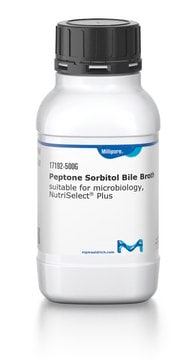18502
Oxidase Reagent according to Gordon-McLeod
suitable for microbiology
Sinónimos:
Gordon-McLeod Reagent
About This Item
Productos recomendados
agency
according to ISO 9308-1:2014
Quality Level
product line
BioChemika
shelf life
limited shelf life, expiry date on the label
composition
N,N-dimethyl-p-phenylenediamine hydrochloride, 0.15 g
water, 10 mL
packaging
pkg of 100 mL
storage condition
(Tightly closed)
technique(s)
microbe id | specific enzyme detection: suitable
antibiotic activity spectrum
Gram-negative bacteria
application(s)
clinical testing
environmental
food and beverages
pharmaceutical
microbiology
suitability
Plesiomonas spp.
Aeromonas spp.
Neisseria spp.
Pseudomonas spp.
bacteria
Categorías relacionadas
General description
Application
signalword
Danger
hcodes
pcodes
Hazard Classifications
Resp. Sens. 1
Storage Class
10 - Combustible liquids
wgk_germany
WGK 2
flash_point_f
Not applicable
flash_point_c
Not applicable
ppe
Eyeshields, Faceshields, Gloves
Choose from one of the most recent versions:
¿Ya tiene este producto?
Encuentre la documentación para los productos que ha comprado recientemente en la Biblioteca de documentos.
Los clientes también vieron
Artículos
Vibrios are motile, curved or comma-shaped bacilli and have a single polar flagella with sheet proteins. They are often found in open water, freshwater and saltwater.
There are many other methods of detection to indicate the presence of E. coli. Review common tests and biochemical reactions for this contaminant.
Specific agars and broths support detection and cultivation of Campylobacter, requiring complex media with essential supplements.
Chromogenic media enable the selective detection of S. aureus, which produce bluish-green colonies that are clearly differentiated from other species.
Protocolos
General guidance for the detection and enumeration of Enterobacteriaceae in food according to EN-ISO 8523:1991 and EN-ISO 4832:1991, respectively.
Listeria is a public health concern, affecting elderly, pregnant, newborns, and immunocompromised individuals.
Nuestro equipo de científicos tiene experiencia en todas las áreas de investigación: Ciencias de la vida, Ciencia de los materiales, Síntesis química, Cromatografía, Analítica y muchas otras.
Póngase en contacto con el Servicio técnico








